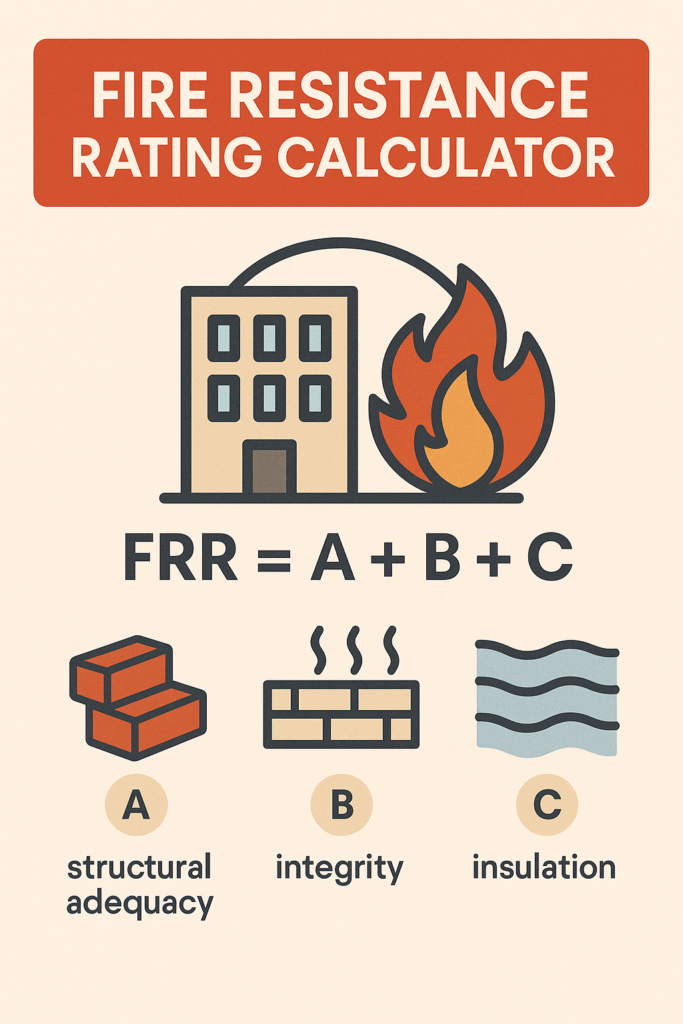Free Fire Resistance Rating Calculator Online
When it comes to designing safe and compliant buildings, estimating the fire resistance rating of structural elements is essential. The fire resistance rating calculator is a specialized tool used by architects, engineers, school districts, and construction professionals to evaluate how long different building components can withstand fire exposure. This tool helps ensure that your design meets code requirements, minimizes risk, and supports real-time decision-making throughout the project lifecycle. For more tools that assist in planning and estimation, explore Construction Calculators.
Fire Resistance Rating Calculator
What is a Fire Resistance Rating Calculator?
A Fire Resistance Rating Calculator is a technical tool that estimates how long materials such as walls, floors, columns, and doors can resist fire without structural failure. Ratings are typically measured in hours (e.g., 1-hour, 2-hour fire resistance) and depend on several variables, including material thickness, construction type, insulation, and exposure conditions.
Designed to support code compliance and energy system protection, this calculator plays a critical role in fire safety planning. It connects building envelope decisions to safety outcomes, affecting everything from HVAC interactions and insulation selection to emissions control and sustainable design assumptions. The calculator also aids school districts and public buildings in ensuring student safety through proper construction detailing.

Why Fire Resistance Rating Matters
Everything affects everything especially when it comes to fire protection. Material choices in walls, floors, and ceilings not only influence energy efficiency, cooling requirements, and annual energy usage, but also determine how a building performs under extreme heat. Using this calculator early in the design phase allows project teams to evaluate different assemblies, check assumptions, and select components that offer both structural integrity and life safety during a fire event.
From back-of-the-envelope calculations to more advanced analysis, this tool supports quick sanity checks and planning accuracy. It’s valuable for any construction or renovation project in the public or private sector, including facilities in school districts like those in Western Washington and beyond.
Core Features of the Fire Resistance Rating Calculator
- Estimates fire resistance ratings in hours based on construction assembly and insulation
- Supports concept-level design and material planning for fire safety compliance
- Calculates how envelope components interact with heat, fire, and energy systems
- Assists architects in selecting fire-rated assemblies for walls, floors, ceilings, and doors
- Enables back-of-the-envelope performance checks for new and existing projects
- Complements energy design tools and sustainability models by integrating safety metrics
- Aids school districts and government buildings in code-compliant planning
- Informs project teams with reliable estimates for structural safety assessments
Formula Overview
The basic estimation can use principles like: $$Fire Resistance Rating (minutes)=k×(Td)2\text{Fire Resistance Rating (minutes)} = k \times \left(\frac{T}{d}\right)^2Fire Resistance Rating (minutes)=k×(dT)2$$
Where:
k = material-specific constant
T = temperature exposure (°C)
d = material thickness (mm)
This simplified expression is used during conceptual planning to check how material thickness affects resistance. More advanced tools factor in thermal conductivity, specific heat, density, and assembly design.
Real-World Applications
Schools and Public Buildings
Districts such as the Snohomish School District and Riverview use fire resistance planning tools when upgrading buildings. Whether it’s evaluating corridor walls, mechanical rooms, or classroom separations, this calculator helps design teams select materials that balance safety, cost, and energy performance.
Commercial Construction
From NAC Architecture to high-performance buildings powered by Slipstream and Schneider Electric systems, fire resistance ratings play a key role. Material selection for stair enclosures, floor systems, and façade elements impacts not just life safety, but also HVAC load calculations and overall envelope efficiency.
Sustainable Projects
Sustainable design is not only about low emissions and efficiency—it’s also about resilience. A building that withstands fire longer reduces damage and contributes to long-term durability. Integrating this calculator with energy design tools allows simultaneous analysis of fire safety and environmental performance.
How to Use the Fire Resistance Rating Calculator
- Select the Assembly Type: Choose from walls, ceilings, columns, or floors
- Input Material Properties: Include thickness, density, and any insulation layers
- Define Exposure Conditions: Choose standard fire curve or custom exposure levels
- View Estimated Rating: Get results in minutes or hours based on the material system
- Apply to Safety Planning: Use values to confirm code compliance or modify the design
- Combine with Envelope Tools: Integrate the data into your overall project planning workflow
Benefits of Early Fire Resistance Calculation
- Reduces rework by aligning early designs with safety codes
- Avoids over- or under-specifying materials, which impacts cost and construction time
- Ensures structural integrity during emergencies while supporting project timelines
- Helps with CO2 emissions planning by minimizing material waste
- Improves overall design coordination and safety validation across project teams
- Supports quick assessments in conjunction with back-of-the-envelope energy tools
Final Thoughts
The Fire Resistance Rating Calculator is a critical component in any construction planning toolkit. It links structural safety to sustainable design, energy system selection, and envelope upgrades. Whether you’re calculating resistance for ground loop heat exchanger rooms or evaluating the impact of a photovoltaic array, this tool ensures your structure remains safe, compliant, and efficient. You can also explore related tools like the General Construction Calculators and Building Occupancy Calculator to support your design and code compliance goals.
From the school district planning level to large-scale commercial builds, this calculator allows everyone from architects to project managers—to make informed, safety-focused decisions at every phase. Use it to support fast estimates, detailed performance metrics, and smarter, safer buildings.
